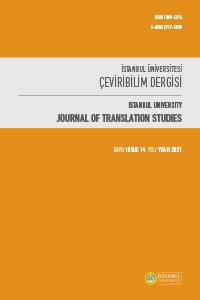Yeniden Yazılan Metinler: Sırça Kümes Ve Sırça Hayvan Koleksiyonu Oyunlarının Oyun Çevirisi Bağlamında İncelenmesi
Öz
Tiyatrobilim ve Çeviribilim alanlarının disiplinlerarası araştırmaya açık olma özellikleri sayesinde tiyatro metinleri çevirisi çift yönlü araştırma alanı yaratmaktadır. Özellikle birden fazla çevirisi olan ve farklı sahnelerde oynanan oyunların incelenmesi, metinlerin çevrildiği döneme ait çeviri poetikası, yaygın çevirmen stratejileri gibi araştırma alanlarında söylemlerin üretilmesine imkân tanımaktadır. Bu çalışmada André Lefevere’in çeviriyi yeniden yazım olarak nitelendiren kuramıyla bağlantı kurarak, erek dizgede farklı dönemlerde hem basılmış hem de sahnelenmiş iki erek metin ele alınmıştır. Amerikan tiyatrosunun önde gelen yazarlarından Tennessee Williams'ın Birinci Dünya Savaşı sonrasında yaşanan Büyük Buhran döneminde geçen, üç kişilik bir ailenin verdiği yaşam mücadelesini ve eve gelen “misafirin” varlığıyla tetiklenen büyük sonunu konu alan The Glass Menagerie metninin Türkçe edebiyat dizgesinde sırasıyla Milli Eğitim Bakanlığı Yayınları ve Mitos Boyut Yayınları tarafından yayımlanan ve Devlet Tiyatroları ile İstanbul Büyükşehir Belediyesi Şehir Tiyatroları gibi ödenekli tiyatrolar ile özel tiyatrolar tarafından sahnelenen çevirmen Can Yücel’in Sırça Kümes ile çevirmen Aytuğ İzat’ın Sırça Hayvan Koleksiyonu metinleri, Marilyn Gaddis-Rose’un uygulaması olan “üç-boyutlu okuma” yöntemi
doğrultusunda karşılaştırmalı olarak okunmuştur. Bu okumada erek metinlerde gözlemlenen çevirmen kararları, tiyatro metinleri çevirisi bağlamında ele alınarak, çevirmenlerin kültürel özelliklerin, tiyatro metinlerinin özelliklerinin ve dilsel anlatım özelliklerinin aktarımındaki seçimleri çeşitli alt başlıklarda incelenerek, çevirmen kararları, yorumları ve çeviri anlayışları olarak yorumlanmıştır.
Anahtar Kelimeler
Yeniden yazım üç boyutlu okuma tiyatro metinleri çevirisi Sırça Kümes Sırça Hayvan Koleksiyonu The Glass Menagerie
Kaynakça
- Bassnett, S. (2002). Translation Studies, Routledge.
- Bassnett, S. & Lefevere, A. (1998). Constructing Cultures: Essays on Literary Translation, Multilingual Matters Ltd.
- Bassnett, S. & Lefevere, A. (1992) Translation, History, Culture, Routledge.
- Dinçel, M. (2016). Yeniden Yazılan Metinler: Sırça Kümes ve Sırça Hayvan Koleksiyonu Oyunlarının Oyun Çevirisi Bağlamında İncelenmesi. Tez (YL). İstanbul: İstanbul Okan Üniversitesi (yayımlanmamış).
- Ece, A. F. (2010). Edebiyat Çevirisinin ve Çevirmeninin İzinde, Sel Yayıncılık.
- Gaddis-Rose, M. (1997). Translation and Literary Criticism: Translation As Analysis, St. Jerome Publishing.
- İzat, A. (2000). Sırça Hayvan Koleksiyonu, Mitos Boyut.
- Lefevere, A. (1992). Translating, Rewriting and Manipulation Literary Fame, Routledge.
- Karantay, S. (Yaz 1989). “Can Yücel ile Söylesi”, Metis Çeviri 8: 11-19.
- Pavis, P. (1999). Sahneleme: Kültürler Kavşağında Tiyatro, Kamber, S. (çev.), Dost Kitabevi Yayınları.
- Williams, T. (2009). The Glass Menagerie, Penguin Books Ltd.
- Yücel, C. (1964). Sırça Kümes, Millî Eğitim Bakanlığı Yayınları.
Rewritten Texts: Comparative Analysis of Sirça Kümes and Sirça Hayvan Koleksiyonu in the Context of Theater Translation
Öz
Translation of theater texts creates a two-way research area, thanks to the openness of both Theater Studies and Translation Studies to interdisciplinary research. In particular, examining plays that exist in more than one translation and that have been staged in different arenas enables comparative research into areas such as translation poetics and common translator strategies during the period of the translation. In this study, two target texts, both published and staged in different periods, have been scrutinized in connection with the theories of André Lefevere, which characterize translation as rewriting. The texts in question are translations of The Glass Menagerie by Tennessee Williams, one of the leading playwrights of 20th century America. This play, set during the Great Depression in the 1930s, depicts the life struggles of a family of three, whose biggest problems are triggered by the presence of a “guest.” Translations of the play entered the Turkish literary system in the forms of Can Yücel's text Sırça Kümes and Aytuğ İzat's text Sırça Hayvan Koleksiyonu, published by the Ministry of Education and Mitos Boyut Publishing respectively. These translations have been staged by state-funded theaters, such as the State Theaters and the Istanbul Metropolitan Municipality City Theaters, as well as by private theaters. The source and target texts were read comparatively, alongside each other according to the “stereoscopic reading” method of Marilyn Gaddis-Rose. In this comparative reading, the translators’ decisions, as observed in the target texts, were analyzed in the context of the translation of theater texts. The choices made, in terms of the transfer of cultural characteristics, characteristics of theater texts, and linguistic expressions, were examined under various sub-headings and explained as translator’s decisions, versions, and interpretations.
Anahtar Kelimeler
Rewriting stereoscopic reading dramatic text translation Sırça Kümes Sırça Hayvan Koleksiyonu The Glass Menagerie
Kaynakça
- Bassnett, S. (2002). Translation Studies, Routledge.
- Bassnett, S. & Lefevere, A. (1998). Constructing Cultures: Essays on Literary Translation, Multilingual Matters Ltd.
- Bassnett, S. & Lefevere, A. (1992) Translation, History, Culture, Routledge.
- Dinçel, M. (2016). Yeniden Yazılan Metinler: Sırça Kümes ve Sırça Hayvan Koleksiyonu Oyunlarının Oyun Çevirisi Bağlamında İncelenmesi. Tez (YL). İstanbul: İstanbul Okan Üniversitesi (yayımlanmamış).
- Ece, A. F. (2010). Edebiyat Çevirisinin ve Çevirmeninin İzinde, Sel Yayıncılık.
- Gaddis-Rose, M. (1997). Translation and Literary Criticism: Translation As Analysis, St. Jerome Publishing.
- İzat, A. (2000). Sırça Hayvan Koleksiyonu, Mitos Boyut.
- Lefevere, A. (1992). Translating, Rewriting and Manipulation Literary Fame, Routledge.
- Karantay, S. (Yaz 1989). “Can Yücel ile Söylesi”, Metis Çeviri 8: 11-19.
- Pavis, P. (1999). Sahneleme: Kültürler Kavşağında Tiyatro, Kamber, S. (çev.), Dost Kitabevi Yayınları.
- Williams, T. (2009). The Glass Menagerie, Penguin Books Ltd.
- Yücel, C. (1964). Sırça Kümes, Millî Eğitim Bakanlığı Yayınları.
Ayrıntılar
| Birincil Dil | Türkçe |
|---|---|
| Bölüm | MAKALELER |
| Yazarlar | |
| Yayımlanma Tarihi | 16 Temmuz 2021 |
| Yayımlandığı Sayı | Yıl 2021 Sayı: 14 |


